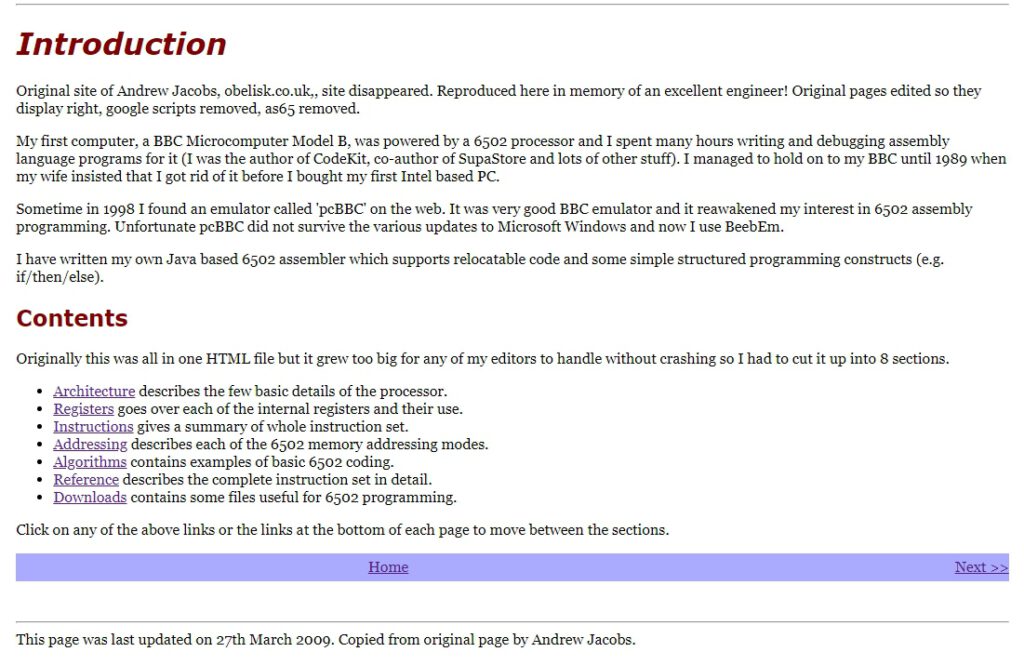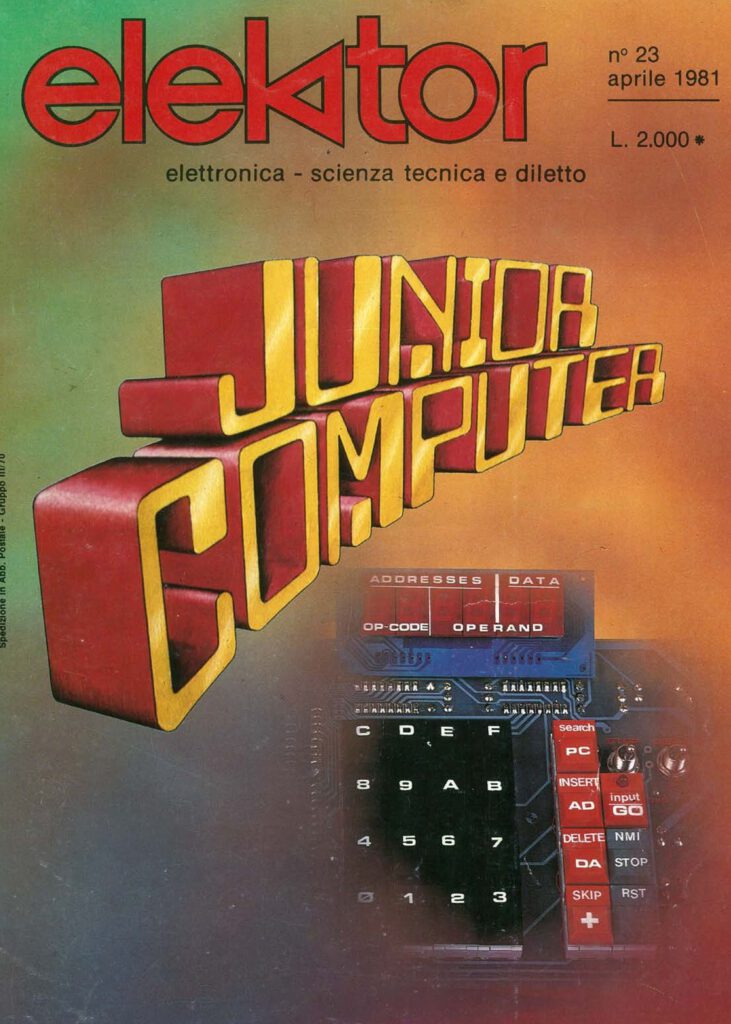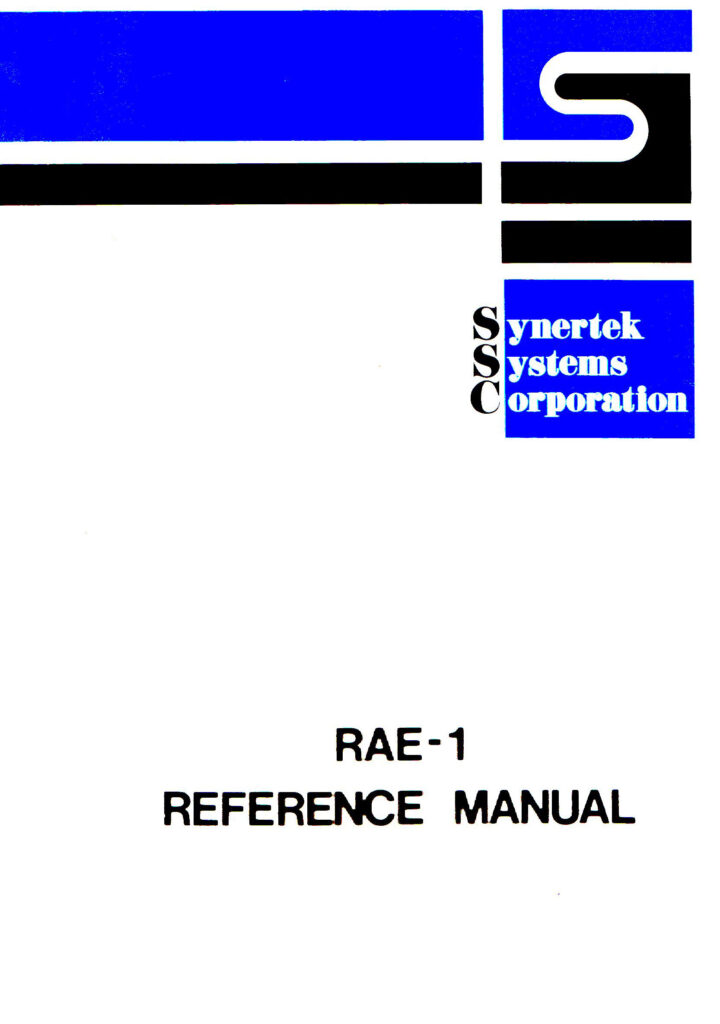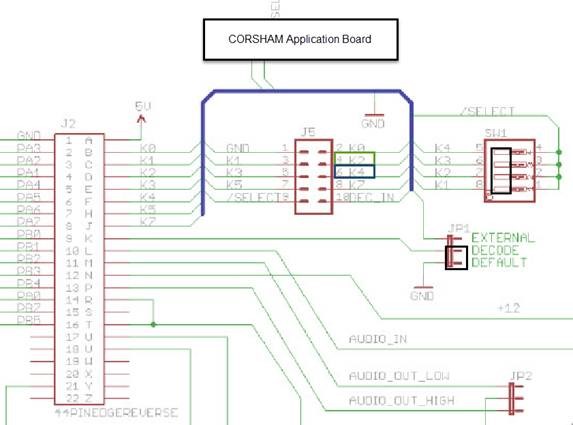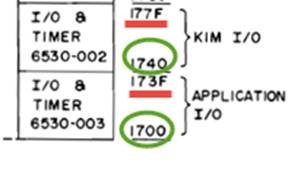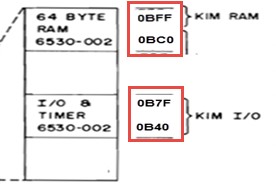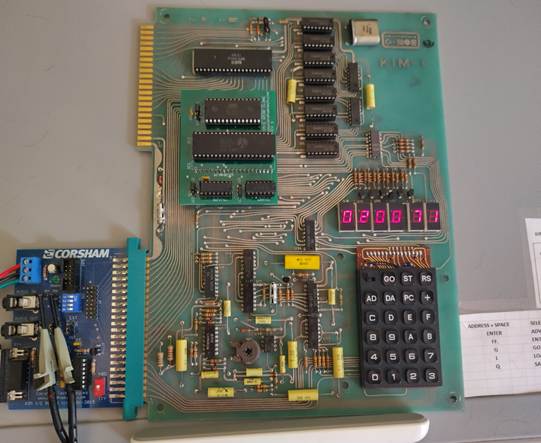Category Archives: 6502
SYM-1 RAE-1 Reference manual, version of 1980
See also:
KIM-1 connectors: beware the Chinese cheap variants!
Magazines: Compute! and Compute II
All documents in the MTU pages are now clean and higher quality, about 50 new PDFs.
Focal-65 V3D for TIM and KIM-1
Junior in KIM Kenner and Comp User
The Dutch KIM User Club published many articles by users on thet Elektor 6502 systems, like the Junior.
4 “De Junior” door Anton Muller
KIM KENNER 13 – 18 oktober 1980
4 Hex teller en flip flop voor de Junior, J. Hummeling
6 Ervaringen met de Junior computer, W.L. van Pelt
KIM KENNER 14 – 20 december 1980
4 JUNIOR, H.J.C. Otten
8 One armed Bandit voor de Junior, F.J. Butterfield
12 Ervaringen met de Junior, J. van Sprang en W.L. van Pelt
14 Junior leesroutine voor Kansas City cassette interface, Sebo Woldringh
16 Junior schrijfroutine voor Kansas City cassette interface, Sebo
De 6502 KENNER nr 15 maart 1980
13 Ervaringen met de JUNIOR J. van Sprang en W.L. van Pelt
15 Letters en cijfers op JUNIOR display J. Hummeling
24 Ervaringen met de Junior, W. Van Pelt en J. van Sprang
26 Automatische register uitlezing voor de Junior
39 Browse voor de Junior
De 6502 KENNER 17 – augustus 1981
12 Ervaringen met de Junior, Willem van Pelt en John van Sprang
De 6502 KENNER 19 – december 1981
Schrijf- en lees routine voor de Junior, Dick Blok
15 Rapportcijfer, Rein Duyts
22 Display op oscilloscope, C. Totte
28 Aanpassingen aan de Macro Assembler van C.W. Moser, van Nieuwenhove Koen
34 Patches op Basic, Hans Otten
35 Lichtshow voor de Junior en de KIM, K. Kikke
38 4 kolom printer, A.S. Hankel
40 Printer routine voor H14, Paul de Beer en Hans Otten
43 Break voor Junior en KIM, Frans Mepschen
De 6502 KENNER 20 – februari 1982 LUSTRUM nummer
79 SYM Microsoft Basic aangepast voor de Junior, door Jaron Orenztajn
81 Aanvullingen voor de Elektuur EPROM programmer, door John van Sprang
85 Aanpassingen Junior print voor 2716, door J. Vollering
86 Bugs
87 Patches Micro Ade deel 11 voor de Junior, door A. Hankel
91 Voedingsschema voor +5V, +12V en -12V. door Frans Smeehuizen
92 Memory test aangepast voor de Junior, door Bert van Tiel
36 Junior’s aan de PET, door Ruud Uphoff
De 6502 KENNER 22 – Augustus 1982
12 Patches op KIM-1 Basic t.b.v. de Junior, door Van Nieuwenhove Koen
De 6502 KENNER 23 – Oktober 1982
11 Patches op KIM-1 Basic t.b.v Junior (deel 2), door Van Nieuwenhove Koen
25 R.T.T.Y. met Junior, Telexberichten via korte golf op uw scherm, door A.S. Hankel
32 Easy Editing Supporter v. Junior, door R.C. Vissers
40 Simpele geheugenuitbreiding, door H. Burgers
43 Single Step Debug Programma, door M. A. v.d. Laan
46 Tiny Basic voor Junior + cassette routine, door Filip van Kenhove
De 6502 KENNER 24 – December 1982
14 Patches op KIM-1 Basic t.b.v Junior (deel 3), door Van Nieuwenhove Koen
4 Cassette bibliotheek, Junior cassette 2
De 6502 KENNER 25 – Februari 1983
6 Patches op KIM-1 Basic t.b.v Junior (deel 4, slot), en bugs in deel 1,2 en 3, door Van Nieuwenhove Koen
24 Junior en dubbel adressering VIA 6522, door Koen van Nieuwenhove
35 AIM-65 Basic voor de Junior, door E.J.M. Visschedijk
4 ReNr en Append voor de SYM-Basic voor Junior
6 Maak van Junior een Senior: Disk drive Systeem van Proton op Junior, door P. Franssen
16 Printen op OKI Microline 80 Printer, een nieuwe printer routine voor Junior
De 6502 KENNER 27 – Augustus 1983
3 Proton’s JUNIOR DOS
3 Spiraal (KIM) nu voor Junior
19 Koppeling van Junior aan 8″ Floppy, met FD1771 controler 8″ single en 5″ double density, door Koen van Nieuwenhove
41 UART schakeling voor Junior, door A.A. Zwart
De
6 Grafisch display voor Junior, door H. Christen
De 6502 KENNER 29 – December 1983
21 Read Junior’s SYM-Basic cassettes with Microsoft KB9 Basic
22 Toevoegen niruwe commando’s aan de SYM-1 Basic voor KIM-1 en Junior, Frans Smeehuyzen
25 Vraag en aanbod
26 Automatisch regels verwijderen, Frans Smeehuyzen
28 Boekennieuws
28 Clear screen voor JUNIOR’s SYM-1 Basic, Will Cuypers
29 Tekstverwerker, naar een idee van M.A. van der Laan
31 Hexadecimaal omzetter, Dick Blok
33 Universele geheugenkaart voor Junior
33 KB9-Basic op Acorn SYSTEM-1
39 Junior’s Hex monitor on Acorn-System, Alfons van de Meutter
De 6502 KENNER 30 – Februari 1984
8 Usurpator, schaakprogramma voor Junior, Fridus Jonkman
9 PACHA, patch on PM monitor, Fernando Lopez
11 Bouw eens een Miljonair: 2 miljoen bytes voor uw Junior, Jam H. Vernimmen
17 Program cassette 1: Junior/Apple formaat cassette routines deel 1, A Brouwer
34 LED’s op Junior, Hans Buurman
37 Uitbreidingen op SYM-1 Basic voor KIM en Junior: automatische regelnummering, Frans Smeehuyzen
39 Missing data in Junior Book 4
47 Load your Junior Sym-Basic Tapes into KB-9
21 KIM-1 en Junior KB-9 Basic Tokenized Microsoft Basic Keywords and addresses, Willem L. van Pelt
28 Aanpassen regelbreeddte via het toetsenbord, Frans SMeehuyzen
47 Extended AIM Basic Junior patch on Basic program compressor
4 Tips & Trics, Wout van Dinther en Gerard van Roekel
29 Junior Command Characters, Coen Kleipool
34 Basicode-2 voor de Junior met SYM-Basic, Fridus Jonkman
36 Hexdump voor de Senior Monitor voo Junior met PROTON’s monitor, Rob Banen
44 UART schakeling voor Junior, A.A. Zwart
44 Textfiles with Junior, Camiel de Ly
De 6502 KENNER 33 – Augustus 1984
3 Epson FX80 printer routine for Junior with OS65D
8 Junior disassembler voor hexdisplay, Fridus Jonkman
17 Low cost Elekterminal Expansion, R. Baarslag
24 Spiraal, grafisch op Junior met VDU kaart, Japp van Toledo
33 Tracer en single step, voortzetting uitbreidingen SYM Basic op Junior, Frans Smeehuyzen
De 6502 KENNER 34 – Oktober 1984
36 Save en load routines PROTON DOS SYM-1 Basic op Junior, Frans Smeehuyzen
33 HEX ascii dump, FORTH Gert Klein
39 Wallbreaker for Junior with OHIO-DOS, Willem Kuitens
42 Maanlander, Maarten van Hintum
44 Junior 8K of Junior 64K, Hans Mooi
De 6502 KENNER 35 – December 1984
5 Junior met VDU kaart Greedy spelprogramma deel 1, Phons Bloemen
48 Junior met D.O.S, Koen van Nieuwenhove Speed
De 6502 KENNER 36 – Februari 1985
5 Junior met VDU kaart Het grafisch display, J.J.A. en J.A.J. Janssen
21 FORTH op Junior deel 1, Gert van Opbroek
24 OHIO DOS V3.3 Aanpassen I/O routines, Wout van Dinther
24 How to change the Memory Map of your FORTH system on Junior
De 6502 KENNER 37 – April 1985
17 Junior met DOSV2.0A Bug in Disc patches on ASSM/Ted, Hans buurman
45 FORTH op Junior computer, Gert van Opbroek
11 Dubbele dobbelsteen Junior met PM Maarten Lamey
22 ID en KB-9 Microsoft Programs, Camiel de Ly
23 VIA ACIA print, M.A. van der Laan
32 Patches op PM Junior
40 Sorting subroutine Junior Fernando Lopez
De 6502 KENNER 39 – Augustus 1985
10 DOS65 JUNIOR, another DOS for the Junior, Coen Kleipool
12 Boekbespreking
13 Time of day, de 6526 nader bekeken, Ruud H. Uphoff
18 Vraag en aanbod
19 Junior met OS65D V3.3 Uitbreidingen, Gert Klein
33 Junior Tape I/O, A.W. den Hertog
35 Ervaringen met de PC-2 computer van Proton Electronics
35 HCC Computerdagen 16/17 nov 1985 reductiebon
36 Tokenized Microsoft Basic Keywords and addresses CBM40XX, CBM 80XX, Nico de Vries
46 Automatische dataregel teller
47 FORTH op Junior deel 3, Gert van Opbroek
De 6502 KENNER 40 -Oktober 1985
39 Junior in Apple, Frans Verberkt
42 C64JUN, Junior leest C64 tapes, R.A.F. Bens
De 6502 KENNER 41 – December 1985
6 Basic teksteditor OHIO DOS Junior, Maarten van Hitum
15 Screen editor V3.0 SCRED 3.0 Junior met VDU kaart voor Basic of Comal, B. de Bruine
De 6502 KENNER 42 – Februari 1986
9 Real-time clock voor de Junior, Clock IC MC146818, M.J. Stiphorst
15 Octopus 65, fout in publicatie FCU kaart Elektuur Special
24 Octopus 65 Let it be, Will Cuypers
26 GRAF V2.4 Routines grafische kaart, J.J. A. JAnssen
38 Basic programma Competitiestanden Handbal Elektuur Junior deel 1, Gerard Keet
De 6502 KENNER 43 – April 1986
16 65(C)02 Vervanging 6502 in Junior, Jan Vernimmen
17 Elektor’s octopus diskettes available
18 Basic competitie standen deel 2, Gerard Keet
23 Een wait ingang voor de Junior, Roger Langeveld
29 Octopus Diskette copier version 2.2, Wolfgang Tietsch
44 Bankswitching for the Junior, Fernando Lopez
1 Inhoudsopgave
2 Alternatieve Break routine tbv CPU kaart, Frans Smeehuyzem
4 Elektor’s OCTOPUS/EC65 computer: A data buffer as afterthought, R.T. Overakker
6 Problem with EC65 poweron reset, Siegfried Losensky
7 Elektor’s Octopus/EC65 Modified diskette copier version 2.2 part 2
18 Junior interface card en gewijzigde VDU card, Pieter de Visser
21 Junior POSVAL Chessmonitor for Elektor with hexdisplay, Frans Raaijmakers
21 EC65 Patch realtime clock
29 Printer initialisation for EC65, Leif Rasmussen
29 EC65 SAMSON tips, Leif Rasmussen
31 Basic competitiestanden part 3, printroutine voor teletype 110 baud
38 Junior with Proton’s Senior monitor modified format lister, Rob Banen
45 6845 geprogrammeerd
48 Delete character routines tbv de Elektor VDU card
De 6502 KENNER 45 – Augustus 1986
3 Elektors EC65 Starcatcher Basic game
42 Junior with VDU OHIO DOS NUMBERS routines to handle input of numbers from the keyboard
12 Realtime clock 146818 IC routines, Frenando Lopez
21 Elektor VDU card modification, J.C. Rix
22 New Centronic routine for Junior/Octopus 65, Coen Boltjes
25 Junior POSVAL Chessmonitor for Elektor with hexdisplay, Frans Raaijmakers
43 Basic competitie standen deel 4, Gerard Keet
46 Use of cursor control keys ED, Rene Hettfleisch
46 Octopus/EC65 disks
De 6502 KENNER nr 46 – october 1986
5 Block graphics on EC65: screendump, Leif Rasmussen
6 An interrupt decoder for the 6809, Andrew Gregory
8 8K RAM voor de Atom, Karel Odon
8 Patch on Dr Tietsch’s copier program, Marc Lacheart
9 A macro loader and Saver for ED DOS65, Bram de Bruine
11 Bitpatroon voorde C64, Gerard van Roekel
11 TIP: 0 in data regels plaatsen, Gerard van Roekel
12 Basicprogrammas’ combineren 2 en 3 letterwoorden, Gert Kwetters, Bart van Pelt
13 Junior bekent kleur, Phons Bloemen
17 Look at real contents Atari, Henk Speksnijder
17 Modification VDU card Octopus65, Albert v.d. Beukel18 Junior POSVAL schaakmonitor part3 end, Frans Raaijmakers
18 Junior Changing the 6502 by a 65C02. Jan Vernimmen
19 Troubles with Micro Ade and Elektor’s Octopus, Marc Lacheart
19 Solution of Micro Ade problem of contineous erros, Ronald Hermans
20 Junior malfunction Display, Ronald Hermens
21 Directory Disk1 ‘System Loys diskette’, Fernando Lopez
22 Bell routine for Octopus/EC65 with Basicode interface card, Coen Boltjes
22 Junior POSVAL wijizigingen in gepubliceerde listing, Frans Raaijmakers
23 Error messages Junior, adapted for Junior, Ronald Hermens
25 PL3/4 straps poblem CPU card, Frans Smeehuijzen
30 Patch in the Octopus/EC65 standard monitor, Marc Lacheart
30 Patches on Disk 5A (Original OSI V3.3) Marc Lacheart
31 Problemen met de Octopus65 met RS232 printer, J.A. van Eken
De 6502 KENNER nr 47 – December 1987
4 Hardware adjustment Junior/Octopus with VDU card for use as a videotext terminel Prestel standard, Coen Boltjes
6 How to adjust the character generator for Videotex, Coen Boltjes
8 Junior Break key with serial keyboard, Gerard van Woerkom
12 Directory Disk 5a Ohio DOS
12 Junior dubbel adressering, Frans Bens
18 Tips and tricks for the EC65K/Junior, Coen Boltjes
19 MON65 op Junior, Erik v.d. Broek
20 The Junior Computer revisited, Fernando Lopes
28 Bell for EC65, Rasmussen and Lindstroem
32 Extension of OS-65D V3.3 with DEL command
38 Screen flickering, Andrew Gregory
38 Slave: bootstrap loader Junior, Ronald Hermens
39 TELEX programma MCB 1984, Marcel Breukink
44 Columns print for printing in two columns, Octopus, Leif Rasmussen
45 Hardcopy routine for Octopus, Coen Boltjes
De 6502 KENNER nr 48 – February 1987
5 Videotex program for the Junior Octopus, Coen Boltjes
26 Ascii dump with OS65D extended monitor, Gerrit van Woerkom
28 Working with Micro Ade and bankswitching on the Junior Computer, Fernando Lopes
De 6502 KENNER nr 49 – April 1987
7 EC65/Octopus Screendump for Kolorator, Leif rasmussen
11 Plotpoints Atari 520ST, Jan Vernimmen
16 Expansion for Ohio DOS Extensions, Coen Boltjes
25 EC65/Octopus How to get more memory space, Peter Linstrom
29 DOS65 ACIA 65C51 and modems. Bram de Bruine
31 Centronics input for DOS65 or Junior computer, Ernst Elderenbosch
32 How to modify the Elektor 64K memory card for use with DOS65, Andrew Gregory
33 Hoe wordt de video controller 6845 geprogrammeerd
39 Forth on the Junior, Frans Bakx
43 Maanlander Junior, Fridus Jonkman
46 Printer routine for Junior, Alfons v.d. Meutter
De 6502 KENNER – nr 50, Juni 1987
4 Fast alternative for the slow Junior cassette interface and software, Hans Christen
8 Solved problems Octopus vdu card monitor EPROM
19 Relocator for DOS Junior and Octopus 65, Coen Boltjes
21 RAM Test program for the Octopus 65, Marc Lacheart
36 Paperware service EPROM programmer for Junior, Andrew Gregory
De 6502 KENNER nr 51 – Augustus 1987
9 EC65/Octopus cassette motor control and Bell hardware, Marc Lacheart
17 EC65/Octopus Wordprocessor V3.0 available, Leif Rasmussen
17 EC65/OctopusPatch on Dr. Tietsch Copier program, P. Lindstrom, Leif Rasmussen
17 Printer problems with the Octopus, Maarten den Hertog
21 Loys extra, how to bind the systemdisk utilities, Leif Rasmussen
28 Junior tape routines on DOS65, Ernst Elderenbosch
26 Octofate: Fate for the Octopus, Coen Boltjes
26 Octopus inputverwerking, A.P. Oerlemans
De 6502 KENNER nr 52 – October 1987
25 EC65 EPROM disk loader
27 EC65 EPROM disk directory
32 EC65 NUMINT basic
34 EC65 Language study help
37 Junior MAZE
De 6502 KENNER 53 – december 1987
30 EC65 Modified version of Elektor’s listing stopper
De 6502 KENNER 57 – Augustus 1988
34 DOS Errors in words EC65
28 EC65K EPROMs programmeren
COMPUSER Volume 1 Nr 2 March 1988
16 Screen noise on Junior with VDU: synchronize CPU and VDU
17 A description of the DOS65 Disc format
24 Tape backup and restore utility OCTOPUS/EC65, Marc Lachaert
35 OHIO DOS V3.X special for Junior, Dirk Picke
COMPUSER Volume 1 Nr 5 March 1988
1 Fractals in assembler EC65 Leif Rasmussen
COMPUSER Volume 2 Nr 1 January 1989
14 Transfer OCTOPUS into a development system, Peter F. de Pauw
34 Read time and date EC65, Peter lindstrom
38 Junior DOS65 Erik vd Broek
See also:
Amazing it works!
Transistors in the KIM-1
History of the TIM in the Jolt
Jolt software
Assemblers used in sources
You can assemble the sources with the assemblers with one of these fine assemblers:
- TASM Telemark assembler, runs on Windows 10 and 11. My favorite.
- A65 assembler, run in DOSBOX or VDOS.
- ASM.80 online assembler
- the assembler from the CC65 suite, powerfull but perhaps overkill for small programs
Other tools that may help you:
- binary file compare (I use freeware WinMerge)
- hex editor (plugin for Notepad++)
- convert between different 8 bit binary files format such as MOS Papertape, Intel Hex, Motorola S-Record, hex dumps. I use my own tool for that: Convert 8bit hex formats
Note that all these assemblers have a different idea about pseudo ops.
- Some require a ‘.’ in front of a pseudo-op like .org
- db, dw instead of .byte, .word
- > < to indicate upper or lower byte, TASM does not know this, use & $FF and >> 8 to mask of upper byte or move upper byte to lower byte.
- 0X or $ to indicate hexadecimal notation
Easy to edit with a Search and Replace usually.
TASM – Notepad++ integration
Install plugin NPPEXEC
- Place TASM in a folder on your disk, e.g. C:\TASM
- Create environment variable TASMTABS with value C:\TASM
- Add c:\TASM to the PATH
Create a NPPEXEC script:
tasm -65 -g3 -s -l -c -fff &quot;$(FILE_NAME)&quot; &quot;$(NAME_PART).bin&quot; &quot;$(NAME_PART).lst&quot; -s &quot;$(NAME_PART).sym&quot;
(-c to combine parts into binary file, -f to fill unused parts in binary with $FF, see TASM manual)
or to produce Intel hex for a programmer:
tasm -65 -x3 -fff -g0 -c -s &quot;$(FILE_NAME)&quot; &quot;$(NAME_PART).ihex&quot; &quot;$(NAME_PART).lst&quot; -s &quot;$(NAME_PART).sym&quot;
(-x3 to allow 65C02 instructions)
Now you can edit a source file, save it (CTRL-S), and press CTRL-F6 to execute the NPPEXEC script. The output of TASM is shown in the windows below the source.
If all is well, a Binary, a listing and a Symbol file is produced.
See also:
Amazing it works!
Transistors in the KIM-1
History of the TIM in the Jolt
Jolt software
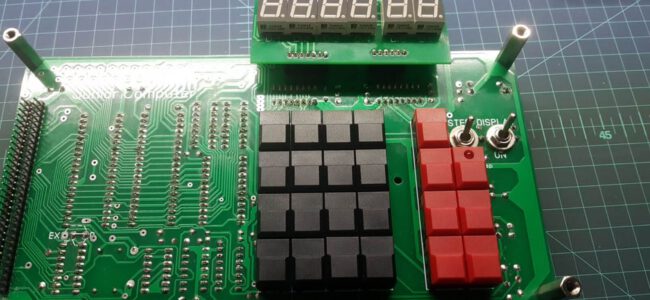
Junior PCBs by Werner Beukes
Text on this page and gerbers by Werner Beukes (original site disappeared late 2022)
The Junior Computer was published in the May 1980 issue of the Elektor magazine. Like many single board computers of that time, it was based on the 6502 microprocessor and the design was more or less the same as the Synertek SYM-1 and the KIM-1.
The Junior Computer was part of a bigger system and a year later in the May and June 1981 issues, the interface card was featured. This was followed by the floppy disc interface in the November 1982 issue. What is notable about this design, was that it did not use any of the exotic and hard-to-find floppy disc controllers (and expensive too).
Other cards that were published but not necessarily for use with the Junior Computer only, were the Universal Memory card (March 1983) – and Universal VDU card (September 1983).
The one thing that puts people off from building something like the Junior Computer, is the printed circuit board. It is no longer available through the Elektor’s PCB service and making one yourself from the layout in the article is just too much effort.
Well, I made building your own Junior Computer a lot easier. Using Sprint Layout 6.0, I replicated the designs for the Junior Computer, Interface board, Floppy Disc Controller, Universal Memory card and Bus board.
The Gerber files for these boards are available free for download and the printed circuit boards made from these files will result in boards which would be identical to the ones you would have received should you have ordered it from the PCB Service..
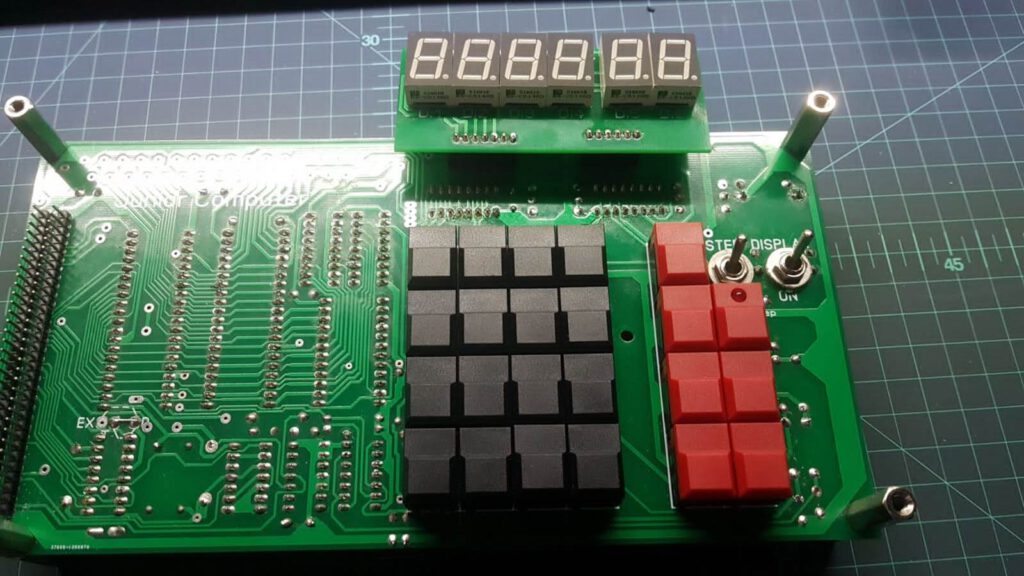
Downloads here:
- Original Junior Computer
This download includes all the Gerber files, the layout file - Modified Junior Computer
There are 2 modifications. The crystal replaced by 1MHz crystal oscillator and 2708 EPROM replaced by 2716 or 28C16 EEPROM. - Interface Card
Project published Elektor May 1981 and June 1981. This was extremely difficult to replicate as the artwork quality was very bad. - Floppy Interface Card
Project published in Elektor November 1982. Design does not use exotic (and hard to find) floppy controllers like the WD1770 etc. - Universal Memory Card
Article published in the Elektor of March 1983. - Bus Board
Required if you want to put a full system together. - Mini Bus Board
Couple Junior and Interface card. - VDU card with BNC
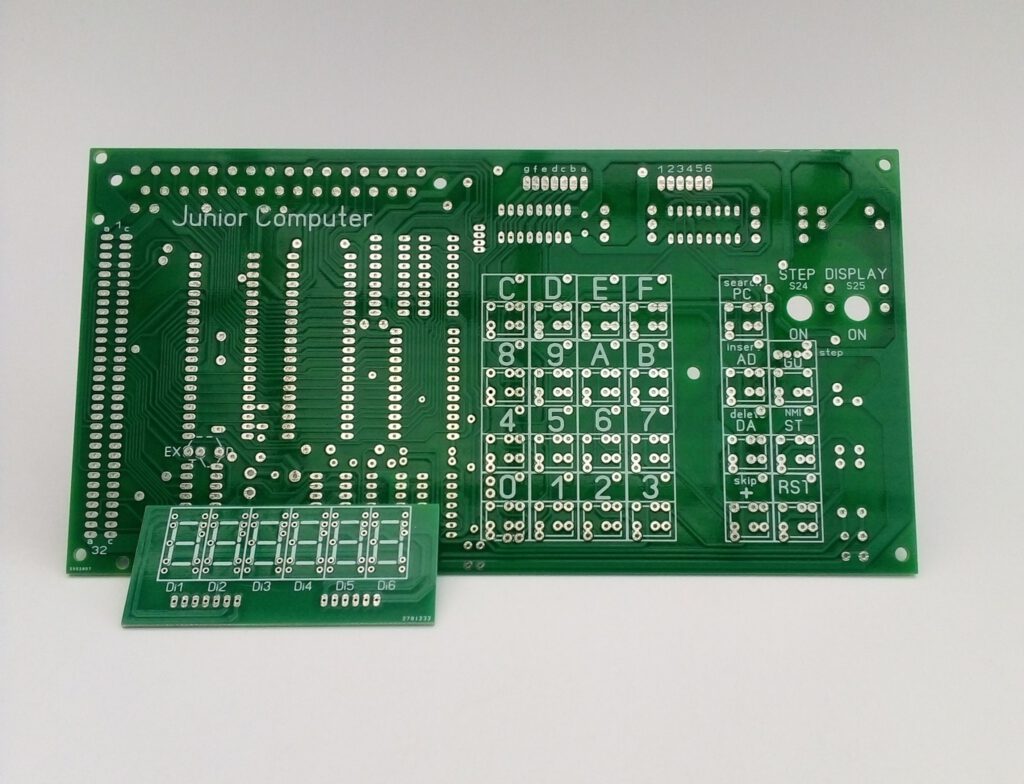
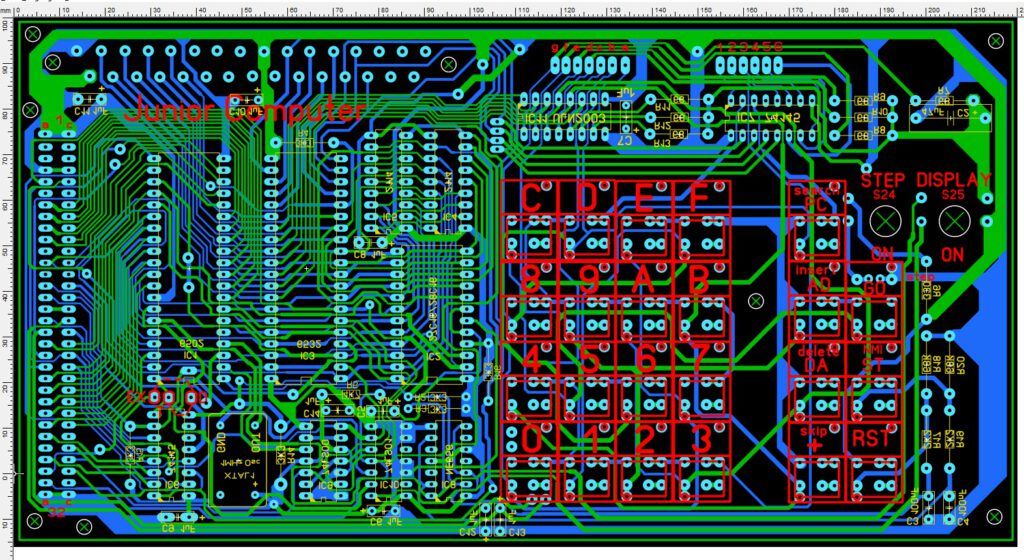
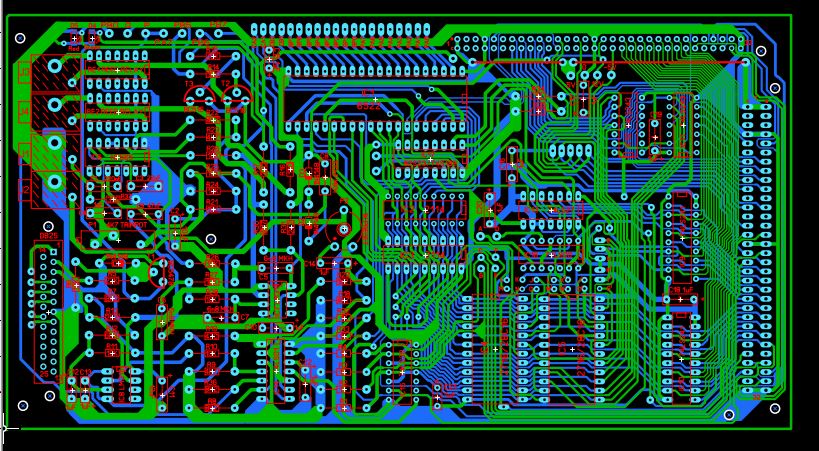
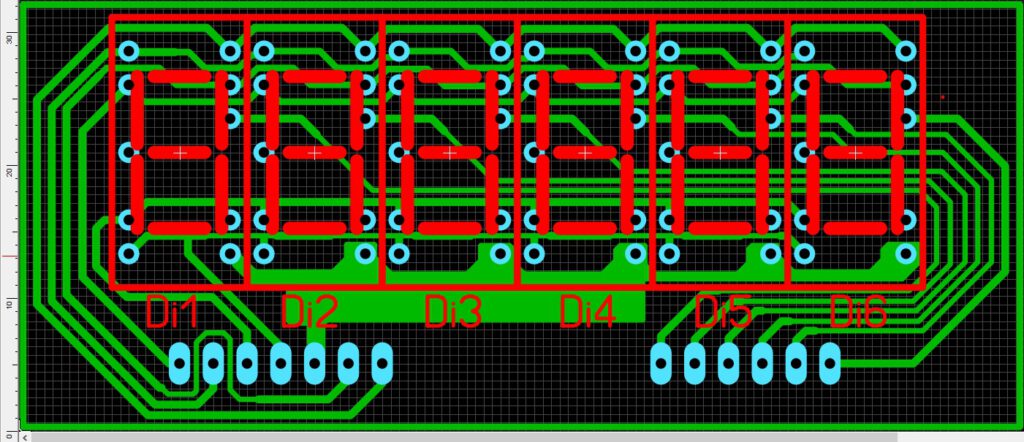
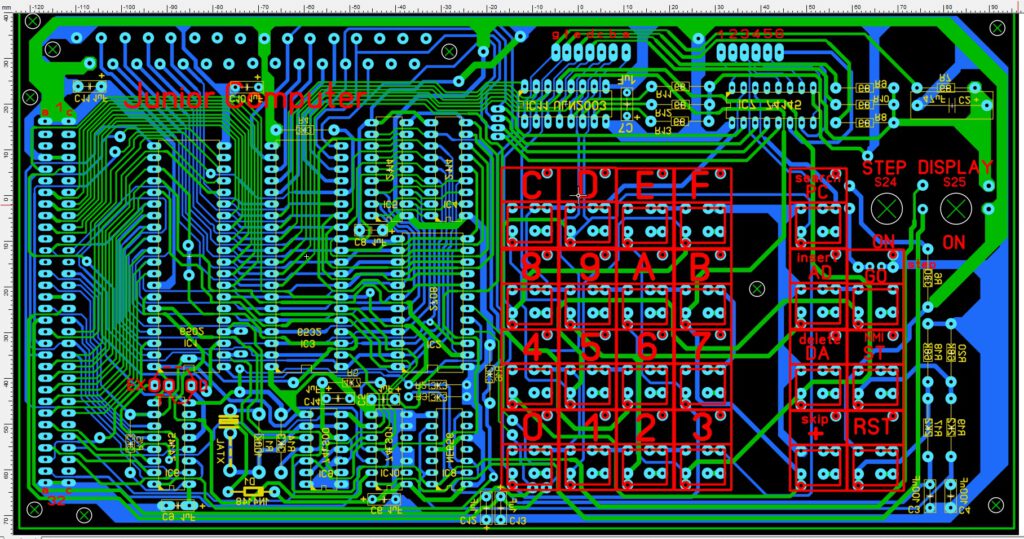
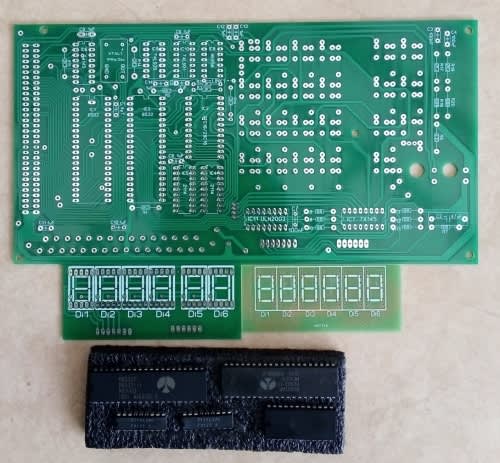
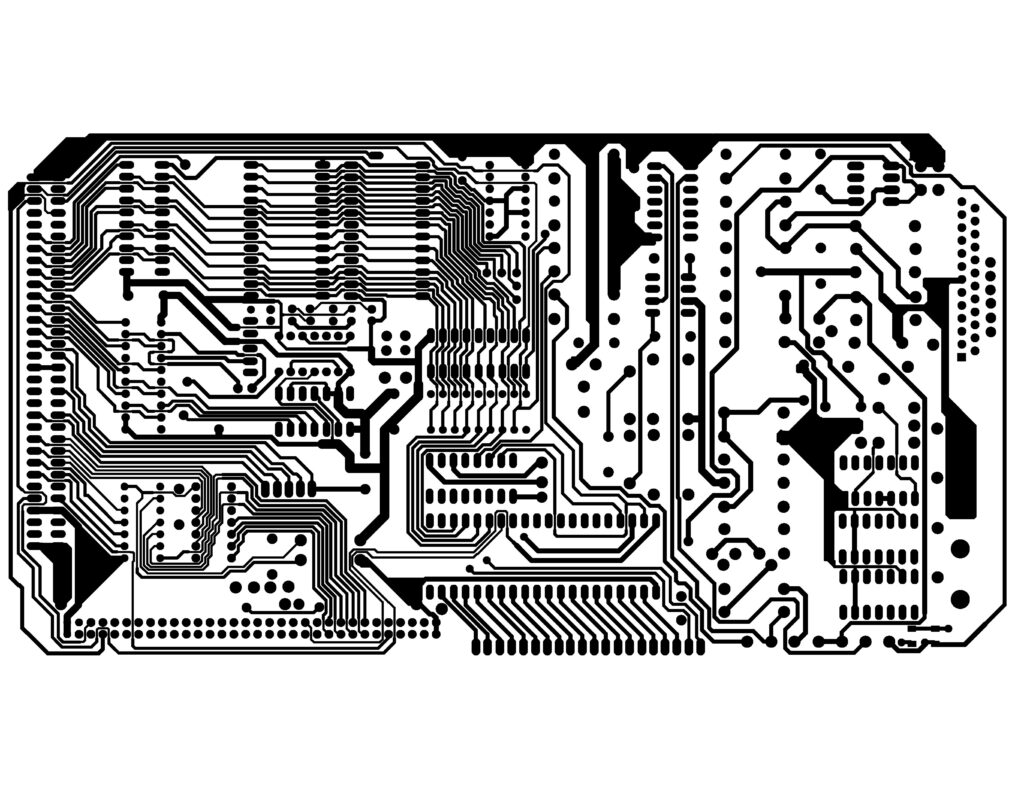
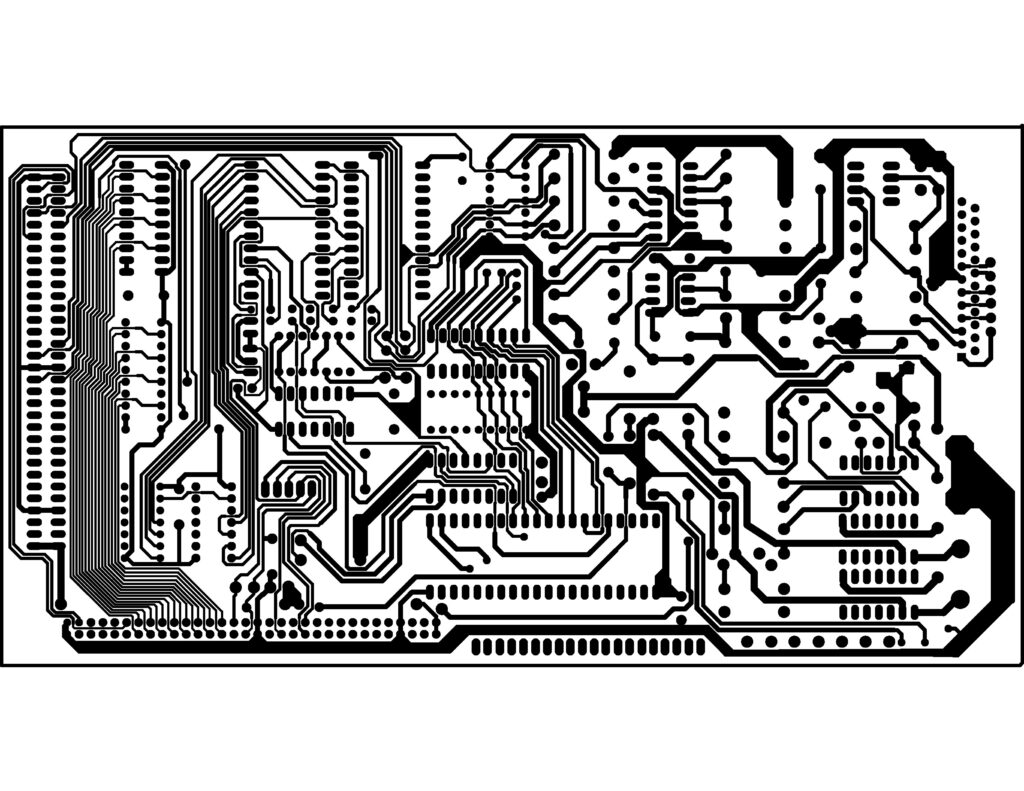
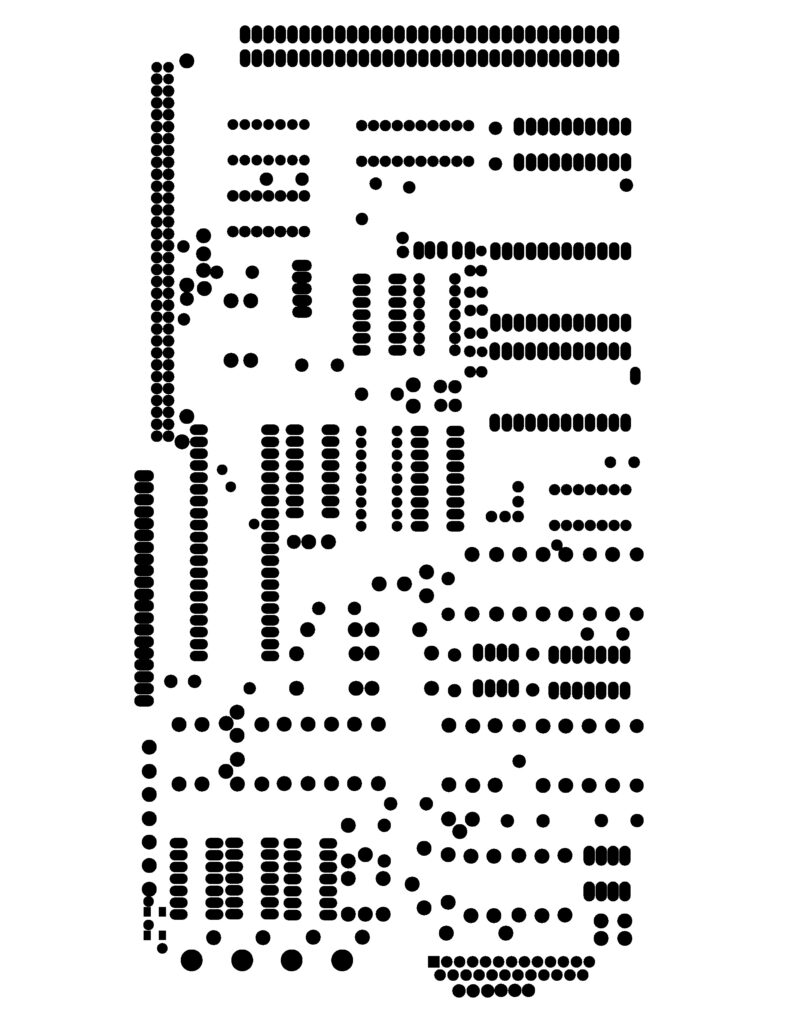
See also:
Amazing it works!
Transistors in the KIM-1
History of the TIM in the Jolt
Jolt software
Focal runs on KIM-1 Simulator
KIM-1 Simulator version 1.1.6 has been published. Get it here.
It now supports Focal-V3D 12-AUG-77 (the Aresco version) from the KIM-1 Software page, see here.
Updates to the Simulator are a working echo suppression (see here for background). Available to any program.
For Focal V3D a setting has to be made in the Settings, to allow Focal to do its magic in the input routine.
By working on Focal I did add comments to the disassembly of what I found. You will find the original by Paul R. Santa-Marie and my partly commented version in the archive.
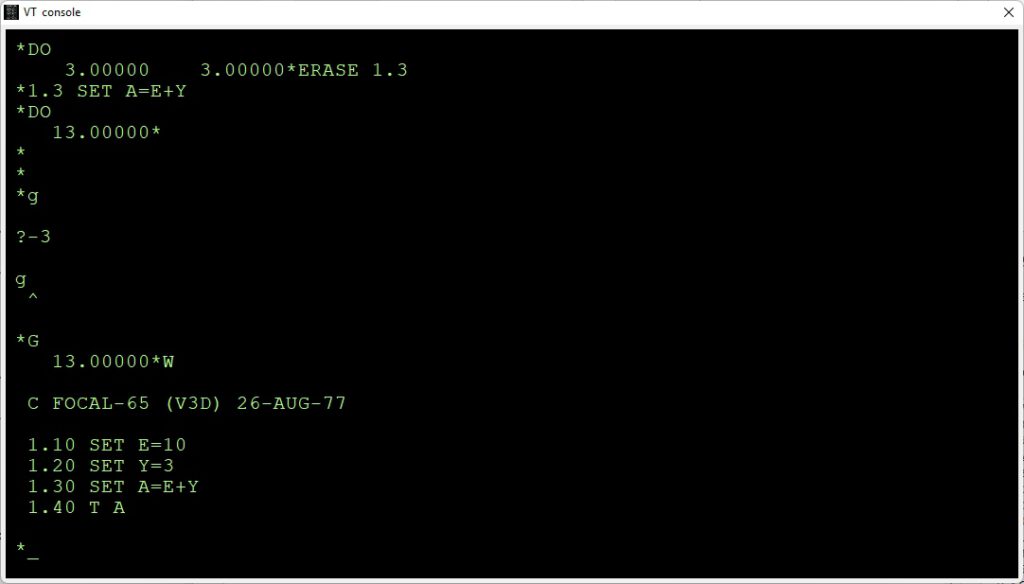
See also:
KIM-1 connectors: beware the Chinese cheap variants!
Magazines: Compute! and Compute II
All documents in the MTU pages are now clean and higher quality, about 50 new PDFs.
Focal-65 V3D for TIM and KIM-1
Testing the 6530-002 RRIOT with a KIM-1
This article is written by Jeff M. Nay, about his experiments to restore a KIM-1 to working order. The challenge was to address the second 6530-002 in this setup at another address then the onboard 6530-002 RRIOT.The experiment was a success, the 6530-002 is indeed in a bad state, the ROM is corrupt and it had to be replaced.The KIM-1, from a friend, was in a bad state. The repair was a success also. He was able to get this old KIM-1 working again, after only having to replace, the 6502 CPU, the 6530-002 RRIOT Chip with a Corsham 6530 Replacement board, all 8 Memory Chips and the U17 7406 inverter. Read the article here
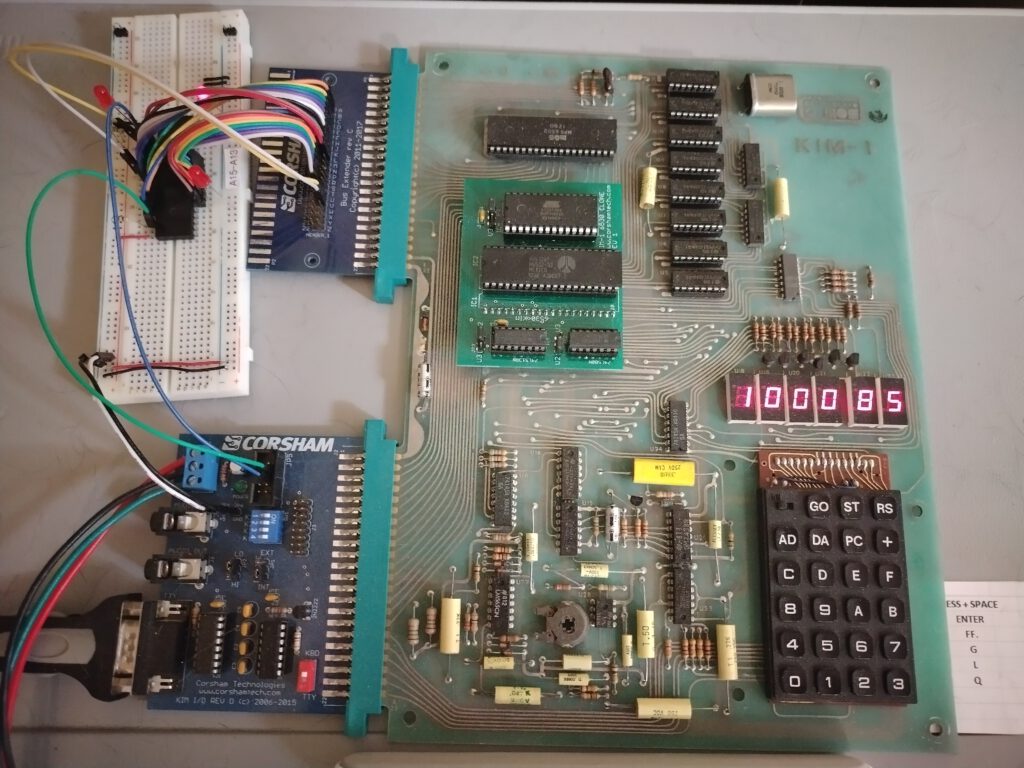
See also:
KIM-1 connectors: beware the Chinese cheap variants!
Magazines: Compute! and Compute II
All documents in the MTU pages are now clean and higher quality, about 50 new PDFs.
Focal-65 V3D for TIM and KIM-1
RRIOT testing on a breadboard 6530-002
This article is written by Jeff M. Nay, about his experiments to restore a KIM-1 to working order, testing the 6530-002 RRIOT with his own KIM-1.
The challenge was to address the second 6530-002 in this setup at another address then the onboard 6530-002 RRIOT. The experiment was a success, the 6530-002 is indeed in a bad state, the ROM is corrupt and it had to be replaced.
The KIM-1, from a friend, was in a bad state. The repair was a success also. He was able to get this old KIM-1 working again, after only having to replace, the 6502 CPU, the 6530-002 RRIOT Chip with a Corsham 6530 Replacement board, all eight memory Chips and the U17 7406 inverter.
Breadboard Test for 6530-002
Attach Breadboard to working KIM-1, using Expansion Port and using K4 and K2 from Application Port (Corsham Application Board)
NOTE: Turn all SW1 switches on CORSHAM Board Off (Or data will repeat at K1,K2,K3,K4)
I started by wiring the data lines on the 6530 to the expansion board pins 15-8.
Then the address lines to pins A-L.
Now it is just a matter of wiring the control lines correctly.
- Phase 2, pin 3 of the 6530 going to pin U of the Expansion board (Yellow)
- Pin 4 (RSO) of the 6530 going to (K4) of my Corsham Application Board – (Don’t forget pull up resistor) (Blue)
- RES pin 16 of the 6530 wired to pin 7 (RST) of the Expansion board
- Pin 18, (CS1) on the 6530. Going to (K2) of my Corsham Application Board – (Don’t forget pull up resistor) (White)
- Power going to pin 20 and Gnd going to pin 1
You should be able to read ROM at $1000
Looking below at the data sheet, where the address of the I/O and RAM are determined by A9-A6. This means it is not hard set for $1700 or $1740.
K5 ($1400) + A9-A6 determines where the IO of both 6530s will start and end.
I ended up using K2, which starts at $0800 + A9-A6 means my I/O registers should start at $0B40 for the 6530-002 or $0B00 for the 6530-003
I also use K4 for the ROM section of the 6530-002 which starts the ROM section at $1000
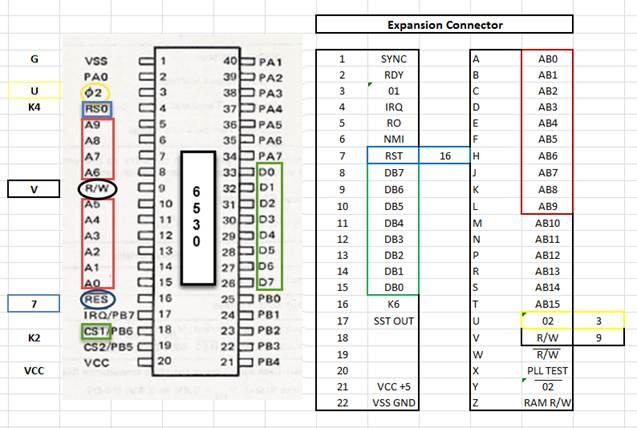
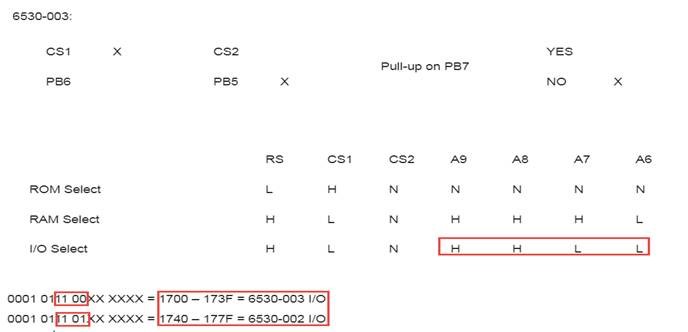
A9+A8 = 1100000000 = 300H to 1100111111 = 33FH(K5) $1400+$300 Start the IO for 6530-003 at $1700.(K5) $1400+$33F End the IO for 6530-003 at $173F6530-002 A9+A8+A6 =1101000000=340H to 1101111111=37FH(K5) $1400+$340 Start the IO for 6530-002 at $1740(k5) $1400+$37F End the IO for 6530-002 at $177F
|
A9+A8=1100000000 =300H to 1100111111=33FH(K2) $0800+$300 Start the IO for 6530-003 at $0B00.(K2) $1400+$33F End the IO for 6530-003 at $0B3F6530-002 A9+A8+A6=1101000000=340H to 1101111111=37FH(K2) $1400+$340 Start the IO for 6530-002 at $0B40(K2) $1400+$37F End the IO for 6530-002 at $0B7F
|
This is the ROM of 6530-002 breadboard being accessed at $1000 (85)

The now working KIM-1:
See also:
Amazing it works!
Transistors in the KIM-1
History of the TIM in the Jolt
Jolt software
KIM-1 and TIM updates
I have added the following to the KIM-2 KIM-3-KIM-4 KIM-5 KIM-6 pages:
– brochure with photos and descriptions and pricelist KIM System Products
– photos of KIM-2 and KIM4 with KIM-4 motherboard with KIM-3b, KIM-5, KIM-6
– brochure TIM System Development Aid with pricelist
The brochure of KIM-5 etc is from Commodore, the KIM-2 RAM was already dropped for a higher capacity KIM-3B. The KIM-5 was still mentioned as product. Alas I have never seen or heard of a KIM-5 in the hands of a user. So the ROMS are lost alas.
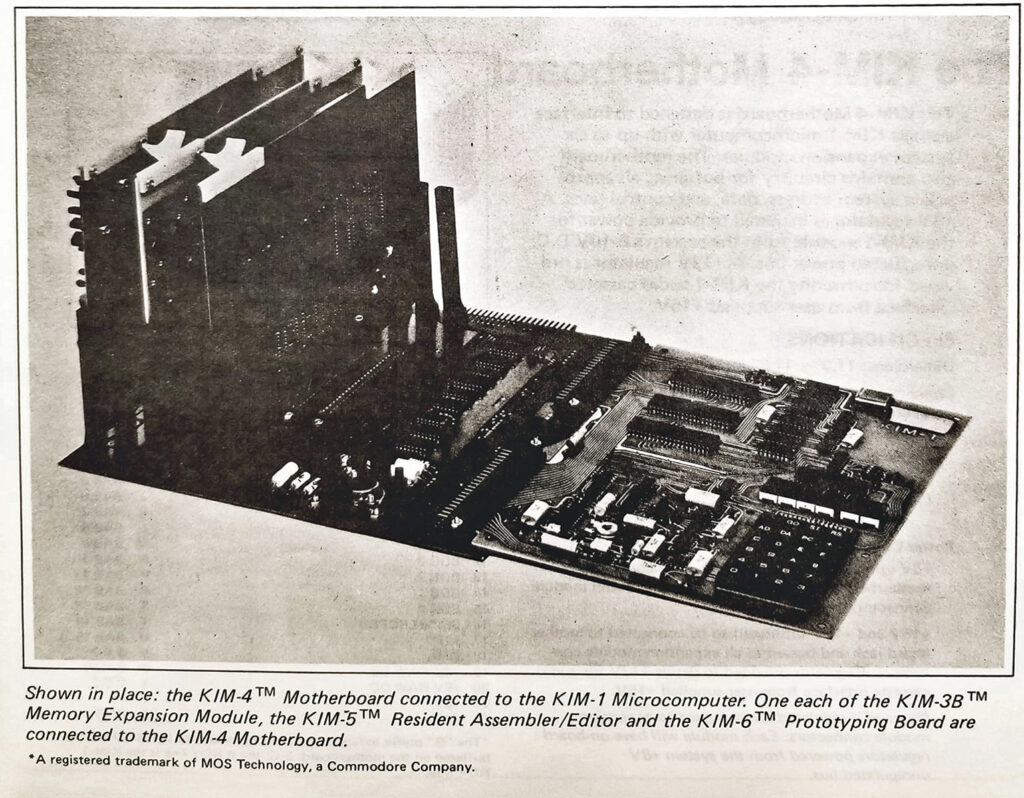
KIM-4 with KIM-3B, KIM-5, KIM-6
See also:
KIM-1 connectors: beware the Chinese cheap variants!
Magazines: Compute! and Compute II
All documents in the MTU pages are now clean and higher quality, about 50 new PDFs.
Focal-65 V3D for TIM and KIM-1
Lost pages of Andrew Jacobs
 The late Andrew Jacobs set up a web site with relevant 6502 information. It is lost now.
The late Andrew Jacobs set up a web site with relevant 6502 information. It is lost now.
This site is reproduced here. Scripts and links are removed, it is clean code now.
Also have a look at his github archive, it is still up.
Enter the local hosted Andrew Jacobs 6502 site here!
